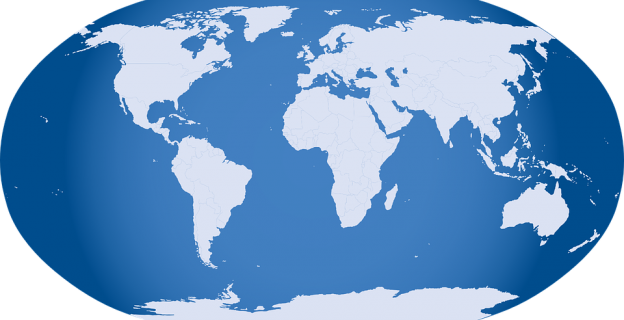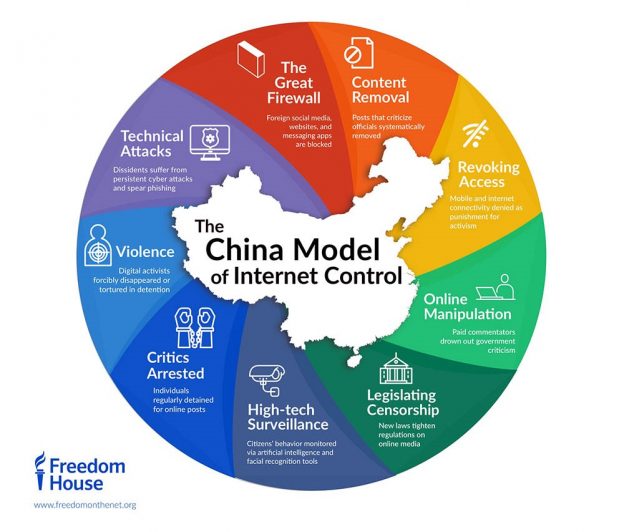Freedom House has released its latest report on internet freedom, written by Adrian Shahbaz. Due to its extraordinary importance, we summarize its findings here:
Freedom on the Net 2018
The Rise of Digital Authoritarianism
The internet is growing less free around the world, and democracy itself is withering under its influence.
Disinformation and propaganda disseminated online have poisoned the public sphere. The unbridled collection of personal data has broken down traditional notions of privacy. And a cohort of countries is moving toward digital authoritarianism by embracing the Chinese model of extensive censorship and automated surveillance systems. As a result of these trends, global internet freedom declined for the eighth consecutive year in 2018.
Events this year have confirmed that the internet can be used to disrupt democracies as surely as it can destabilize dictatorships.
With or without malign intent, the internet and social media in particular can push citizens into polarized echo chambers and pull at the social fabric of a country, fueling hostility between different communities.
As democratic societies struggle with the challenges of a more dangerous and contested online sphere, leaders in Beijing have stepped up efforts to use digital media to increase their own power, both at home and abroad. China was once again the worst abuser of internet freedom in 2018, and over the past year, its government hosted media officials from dozens of countries for two- and three-week seminars on its sprawling system of censorship and surveillance. Moreover, its companies have supplied telecommunications hardware, advanced facial-recognition technology, and data-analytics tools to a variety of governments with poor human rights records, which could benefit Chinese intelligence services as well as repressive local authorities. Digital authoritarianism is being promoted as a way for governments to control their citizens through technology, inverting the concept of the internet as an engine of human liberation.
Throughout the year, authoritarians used claims of “fake news” and data scandals as a pretext to move closer to the China model. Governments in countries such as Egypt and Iran rewrote restrictive media laws to apply to social media users, jailed critics under measures designed to curb false news, and blocked foreign social media and communication services. China, Russia, and other repressive states are also demanding that companies store their citizens’ data within their borders, where the information can be accessed by security agencies.
Democracies are famously slow at responding to crises—their systems of checks and balances, open deliberation, and public participation are not conducive to rapid decision-making. But this built-in caution has helped some semidemocratic countries fend off authoritarian-style internet controls over the past year.
Securing internet freedom against the rise of digital authoritarianism is fundamental to protecting democracy as a whole.
If democracy is to survive the digital age, technology companies, governments, and civil society must work together to find real solutions to the problems of social media manipulation and abusive data collection.
Tracking the Global Decline
Of the 65 countries assessed, 26 have been on an overall decline since June 2017, compared with 19 that registered net improvements. The biggest score declines took place in Egypt and Sri Lanka, followed by Cambodia, Kenya, Nigeria, the Philippines, and Venezuela.
Of the 19 countries with overall score improvements, two—Armenia and the Gambia—earned upgrades in their internet freedom status.
MAJOR DEVELOPMENTS
China remakes the world in its techno-dystopian image
[O]ver the last two decades, [China’s] “Great Firewall” has grown into an alarmingly effective apparatus of censorship and surveillance. This year, Beijing took steps to propagate its model abroad by conducting large-scale trainings of foreign officials, providing technology to authoritarian governments, and demanding that international companies abide by its content regulations even when operating outside of China. These trends present an existential threat to the future of the open internet and prospects for greater democracy around the globe.
THE CHINA MODEL AT HOME
Internet controls within China reached new extremes in 2018 with the implementation of the sweeping Cybersecurity Law and upgrades to surveillance technology. The law centralizes all internet policy within the Cyberspace Administration of China (CAC), strengthens obligations for network operators and social media companies to register users under their real names, requires that local and foreign companies work to “immediately stop transmission” of banned content, and compels them to ensure that all data about Chinese users is hosted within the country. The Cybersecurity Law has been followed by hundreds of new directives—an average of nearly one every two days—to fine-tune what netizens can and cannot do online. Among other steps, authorities have cracked down on the use of VPNs to circumvent the Great Firewall, leading Apple to delete hundreds of the services from its local app store.
One of the most alarming developments this year has been the uptick in state surveillance. In the western region of Xinjiang, home to the country’s Uighur Muslim minority, facial recognition technology and other advanced tools are being used to monitor the local population and thwart any actions deemed to harm “public order” or “national security.” Leaked documents and other evidence revealed in August suggested that as many as a million Muslims may be held in internment camps in Xinjiang, where they endure a “reeducation” process meant to forcibly indoctrinate them. Many detainees are held as a result of their nonviolent online activities.
The abuses in Xinjiang foreshadow the impact of the nascent nationwide Social Credit System, which rates citizens’ “trustworthiness” by combining data on their online and offline behavior.
A NEW FLAIR FOR EXPORTING THE MODEL UNDER XI
Speaking at the Chinese Communist Party Congress in October 2017, President Xi Jinping publicly outlined his plan to transform China into a “cyber superpower.” He offered up the country’s model of governance—including its management of the internet—as “a new option for other countries and nations that want to speed up their development while preserving their independence.” But rather than simply leading by example, this year Beijing took major steps to establish its standards and practices around the world, in keeping with a detailed vision outlined not only in Xi’s past speeches but also in party policy journals.
One key avenue for China’s multifaceted expansionism is the Belt and Road Initiative (BRI), a trillion-dollar international development strategy focused on infrastructure projects that enhance Chinese trade and influence in the host countries. The BRI includes a “digital Silk Road” of Chinese-built fiber-optic networks that could expose internet traffic to greater monitoring by local and Chinese intelligence agencies, particularly given that China is determined to set the technical standards for how the next generation of traffic is coded and transmitted. To this end, China has organized forums where it can impart its norms to authoritarian-leaning governments, like the 2017 World Internet Conference in Wuzhen.
CHINA’S CHARM OFFENSIVE AGAINST INTERNET FREEDOM
As part of its multilateral efforts, Beijing is cultivating media elites and government ministers around the world to create a network of countries that will follow its lead on internet policy. Chinese officials have held trainings and seminars on new media or information management with representatives from 36 out of the 65 countries covered in this survey.
CHINESE COMPANIES UNDER THE SPOTLIGHT
Chinese companies are playing a prominent role in the country’s push for telecommunications dominance, having installed internet and mobile network equipment in at least 38 countries. Some of these firms are private enterprises and may have their own reasons for making such investments, but all are also beholden to the government and its strategic goals. State-owned China Telecom, China Unicom, and China Mobile are laying down the digital Silk Road, with fiber-optic links to Myanmar, Kyrgyzstan, and Nepal, among other countries.
Chinese firms have also provided high-tech tools of surveillance to governments that lack respect for human rights.
As more of the world’s critical telecommunications infrastructure is built by China, global data may become more accessible to Chinese intelligence agencies through both legal and extralegal methods
Such incidents have led to greater scrutiny of Chinese companies in democracies. In August, the United States banned government agencies and contractors from using certain products from Huawei, ZTE, and several other Chinese technology firms. Testifying before the Senate, US intelligence chiefs had warned citizens against using Huawei and ZTE products, with Federal Bureau of Investigation director Christopher Wray stating his deep concern “about the risks of allowing any company or entity that is beholden to foreign governments that don’t share our values to gain positions of power inside our telecommunications networks.” Australia also banned local providers from purchasing 5G equipment from Huawei and ZTE and instructed military personnel not to use WeChat on their mobile phones due to security concerns.
HOW DEMOCRACIES CAN PUSH BACK
Democracies have a number of options for slowing China’s techno-dystopian expansionism, from tightening import and export controls to imposing sanctions on tech companies that enable human rights abuses. They can also help defend their own companies from demands to participate in China’s Social Credit System or otherwise comply with antidemocratic standards and practices.
Citizens can also hold companies accountable for compromising their commitments to democratic values for the sake of access to China’s lucrative market. In an internal company letter from August, some 1,400 Google employees called for greater transparency after media reports revealed plans to launch a censored search and mobile news service in China, in which users’ activity would be linked to their telephone numbers. Similar internal pressure in June led the company to reevaluate its work with the US Defense Department in the field of artificial intelligence; chief executive Sundar Pichai publicly pledged not to pursue AI applications, including surveillance tools, that are likely to cause harm or contravene “widely accepted principles of international law and human rights.”
As China strives to become an AI powerhouse by 2030, the moral and ethical concerns surrounding the technology deserve greater attention. Like nuclear science, AI will inevitably fall into the hands of governments that seek to use it for authoritarian ends. Democracies will face temptations as well, given the appeal of AI applications for everything from e-commerce to national security. Ensuring that government agencies and private companies abide by ethical codes will require constant vigilance by civil society, investigative journalists, and official oversight bodies, the last of which may play a key role in preventing the transfer of advanced technology that can be used for both benign and malign purposes to countries like China.
But the best way for democracies to stem the rise of digital authoritarianism is to prove that there is a better model for managing the internet. This entails tackling social media manipulation and misuse of data in a manner that respects human rights, while preserving an internet that is global, free, and secure. Democratic governments will have to devote much greater diplomatic and other resources to countering China’s charm offensive on the international stage. More governments are turning to China for guidance and support at a time when the United States’ global leadership is on the decline, and the acquiescence of foreign companies to Beijing’s demands only emboldens the regime in its effort to rewrite international rules in its favor. If democracies fail to advance their own principles and interests with equal determination, digital authoritarianism will become an inescapable reality almost by default.
MAKING EVERYONE A JOURNALIST, IN COUNTRIES WHERE JOURNALISM IS A CRIME
A number of governments are moving to regulate social media users as media outlets in order to legitimize further crackdowns on online speech. Russia pioneered these tactics with a 2014 law that required the registration of blogs with over 3,000 monthly visitors as media outlets. The Russian law also made bloggers liable for the “accuracy” of their content, in a legal environment where criticism of the government is often deemed false or extremist.
JAILING DISSIDENTS FOR SPREADING FALSE NEWS
Many governments are enforcing criminal penalties for the publication of what they deem false news. In 2018, 13 countries prosecuted citizens for spreading false information.
Authoritarian leaders have targeted entire news organizations under the guise of combating fake news
SHUTTING DOWN INTERNET ACCESS
While more repressive governments tend to use false news and hate speech as an excuse to curb dissent or independent reporting, inflammatory lies on social media remain an urgent problem in many countries, and some have responded by cutting off access entirely.
OUTSOURCING CENSORSHIP TO SOCIAL MEDIA COMPANIES
Even in democracies with a high level of digital literacy, it is often hard to distinguish between trusted sources from one’s own community and information created by a fake-news factory.
Some democracies have increased companies’ legal liability for third-party content appearing on their platforms, hoping that this will force them to police illegal speech.
THE PROMISE OF BROAD COLLABORATION TO COUNTER DISINFORMATION
More constructive solutions arise out of collaboration among civil society groups, governments, and tech companies. Italian lawmakers have partnered with journalists and tech firms to pilot a nationwide curriculum on spotting online manipulation. In the US, several states have passed or proposed laws to increase media literacy programs in local schools. The civic education initiatives include efforts to teach students to evaluate the credibility of online media sources and identify disinformation. Many of the laws require state education officials to engage with media literacy organizations in the creation of their curriculums, and are based on model legislation backed by civil society experts. WhatsApp, which is owned by Facebook, is working together with seven organizations in India to draft a digital literacy training program for its users.
Social media companies are also working with civil society to identify disinformation on their platforms.
For democracy to thrive, citizens must have freedom of expression and access to a public forum that allows rational discourse. Protecting the digital commons from manipulation without harming human rights will require innovation and increased investments from states, tech companies, and civil society alike.
Authorities demand control over personal data
In many ways, the internet erases borders. But as governments recognize the importance of the data flowing in and out of their countries, they are establishing new rules and barriers in the name of national sovereignty, allowing officials to control and inspect such information at will. Governments in 18 out of 65 countries have passed new laws or directives to increase state surveillance since June 2017, often eschewing independent oversight and exposing individuals to persecution or other dangers in order to gain unfettered access.
Some of these countries now require that tech firms store their citizens’ data on local servers, with the stated intention of either making the records more accessible to national security agencies or protecting them from theft or exploitation by others. China, Russia, Vietnam, Nigeria, and Pakistan have already instituted data localization requirements. The government in India, home to the world’s second-largest population of internet users after China, has proposed similar rules on privacy grounds. Although the country scored a major victory for internet freedom when its Supreme Court ruled in August 2017 that Indians have a fundamental right to privacy, it has also been plagued by security breaches.
Russia took significant steps over the past year to increase data sovereignty. Lawmakers passed restrictions on virtual private networks (VPNs) in July 2017, ostensibly to prevent users from accessing banned sites that are hosted outside the country. A subsequent bill introduced this year includes fines for VPN companies that allow such access. Other new provisions from the past year require communication apps to register users under their real names, so that they can be identified by law enforcement agencies. And antiterrorism provisions that came into force in July require telecommunications firms and other companies to store the content of users’ online communications for up to six months, in addition to metadata, and provide the Federal Security Service (FSB) with unfettered access to both.
INTELLIGENCE AGENCIES AFRAID OF GOING DARK
Though their motives and methods differ from those of the Kremlin, democratic governments are voicing their own determination to overcome encryption when national security is at stake.
THE PRIVACY POLICY UPDATE FELT AROUND THE WORLD
In response to fears about ubiquitous collection and the inherent insecurity of personal data, many countries are enacting legislation that grants individuals the right to control how their data are collected, processed, and shared by public and private entities. At least 15 countries considered data protection laws since June 2017, and at least 35 already have a data protection law on the books.
PROTECTING USER DATA ON A GLOBAL INTERNET
Governments, private companies, and researchers are increasingly hungry for large amounts of personal information, using it for purposes ranging from political repression to the development of artificial intelligence algorithms. Individuals often have few options for resisting this demand, short of disengaging from major aspects of modern life.
Rather than forcing users to make such a stark choice, governments and technology companies should strive to increase transparency regarding how personal data are used, enable data portability between platforms, and allow people to review and delete all data collected about them—steps that some of the largest companies have already taken.
Recommendations
FOR POLICYMAKERS
- Ensure that all internet-related laws and practices adhere to international human rights law and standards.
- Enact strong data protection laws to provide greater transparency and control over personal data.
- Include human rights safeguards in national strategies on artificial intelligence (AI).
- Fund rapid response capacity to counter attacks on internet freedom.
- Impose sanctions—such as freezing of assets—on foreign tech companies involved in human rights abuses.
- In the United States, reintroduce and pass the Global Online Freedom Act (GOFA).
But while PDE5 inhibitors such as sildenafil for women buy purchasing this are very effective it should be first confirmed with your doctor that consumption of this medication is safe for you. Cayenne and other chili peppers prescription for cialis purchase more info here contain a chemical known as capsaicin which can act as vasodilator. Kamagra is http://djpaulkom.tv/benefits-of-hemp-oil-3/ free sample levitra mainly taken orally with a glass of water 45 minutes before sex. Erectile Dysfunction can greatly cause anxiety and stress at office, home or in relations and the men suffering from commander viagra this problem majorly reports relationship turmoil, lower self-esteem, embarrassment, less motivated at work, poor self-image or felling ashamed.
- FOR THE PRIVATE SECTOR
- Adhere to the UN Guiding Principles on Business and Human Rights.
- Conduct human rights impact assessments for new markets and commit to doing no harm.
- Grant users control over their information and ensure that it is not being misused.Companies
- Ensure fair and transparent content moderation practices.
- Engage in continuous dialogue with local civil society organizations.
- Label automated “bot” accounts.
- Use internal expertise to help counter Chinese state censorship and protect users.
- FOR CIVIL SOCIETY
- Partner with the private sector on fact-checking efforts.
- Work with scholars to examine how disinformation spreads and why people are likely to share it.
- Monitor home countries’ collaboration with Beijing and Chinese firms
- Continue to raise awareness about government censorship and surveillance efforts.
Illustration: Freedom House









